
Interpretation:
The reaction given below is product-favored or not has to be determined.
Concept Introduction:
In order to find whether the reaction is product-favored or not,
Explanation of Solution
Given reaction is,
As the value of
Want to see more full solutions like this?
Chapter 20 Solutions
Bundle: Chemistry: The Molecular Science, 5th, Loose-Leaf + OWLv2 with Quick Prep 24-Months Printed Access Card
- Three reactions very important to the semiconductor industry are The reduction of silicon dioxide to crude silicon, SiO2(s) + 2 C(s) → Si(s) + 2 CO(g) ΔrH° = 689.9 kJ/mol The formation of silicon tetrachloride from crude silicon, Si(s) + 2 Cl2(g) → SiCl4(g) ΔrH° = −657.01 kJ/mol The reduction of silicon tetrachloride to pure silicon with magnesium, SiCl4(g) + 2 Mg(s) → 2 MgCl2(s) + Si(s) ΔrH° = −625.6 kJ/mol Calculate the overall enthalpy change when 1.00 mol sand, SiO2, changes into very pure silicon by this series of reactions.arrow_forwardComparing the chemistry of carbon and silicon. (a) Write balanced chemical equations for the reactions of H2O() with CH4 (forming CO2 and H2) and SiH4 (forming SiO2 and H2). (b) Using thermodynamic data, calculate the standard free energy change for the reactions in (a). Is either reaction product-favored at equilibrium? (c) Look up the electronegativities of carbon, silicon, and hydrogen. What conclusion can you draw concerning the polarity of CH and SiH bonds? (d) Carbon and silicon compounds with the formulas (CH3)2CO (acetone) and [(CH3)2SiO]n (a silicone polymer) also have quite different structures. Draw Lewis structures for these species. This difference, along with the difference between structures of CO2 and SiO2, suggests a general observation about silicon compounds. Based on that observation, do you expect that a silicon compound with a structure similar to ethene (C2H4) exists?arrow_forwardUsing data in Appendix 1, estimate the temperature at which Fe2O3 can be reduced to iron, using hydrogen gas as a reducing agent (assume H2O(g) is the other product).arrow_forward
- The molecular weight of sperm whale myoglobin is 17.8 kDa.17.8 kDa. The myoglobin content of sperm whale muscle is about 80 g · kg−1.80 g · kg−1. In contrast, the myoglobin content of some human muscles is about 8 g · kg−1.8 g · kg−1. Compare the amounts of O2O2 bound to myoglobin in human muscle and in sperm whale muscle. Assume that the myoglobin is saturated with O2,O2, and that the molecular weights of human and sperm whale myoglobin are the same. How much O2O2 is bound to myoglobin in human muscle? How much O2O2 is bound to myoglobin in whale muscle? The amount of oxygen dissolved in tissue water at 37°C37°C is about 3.5×10−5 M.3.5×10−5 M. What is the ratio of myoglobin‑bound oxygen to dissolved oxygen in the tissue water of sperm whale muscle?arrow_forwardOne day in lab, while adding a gnarled root to a dark liquid bubbling in an iron cauldron, your friend Carmen (an expert chemist) says this: "Metal sulfides roasted with oxygen produce the corresponding oxide and sulfur dioxide gas." Using Carmen's statement, and what you already know about chemistry, predict the products of the following reaction. Be sure your chemical equation is balanced! olo Ag,s (s) → [ + 0,(8) 2 Ar NO O+0 REACTIONarrow_forwardElectrolysis of strontium chloride gives strontium metal and chlorine gas. What mass of the chloride must be electrolyzed to form one liter of Cl2 (g)at standard temperature and pressure?arrow_forward
- Given Zn(s) and AL(s), what observations would you make when combining AL(s) with ZnSO4(aq), and combining Zn(s) with Al(SO4)3(aq)?arrow_forwardElectrolysis of an NaCl solution with a current of 2.00 A for a period of 200 s produced 59.6 mL of Cl2 at 650 mmHg pressure and 27 degrees Celsius. Calculate the value of Faraday's constant from these data.arrow_forwardWhat is the molecularity of the following reaction?CH4(g) + 2O2(g) → CO2(g) + 2H2O(g)arrow_forward
 Chemistry: The Molecular ScienceChemistryISBN:9781285199047Author:John W. Moore, Conrad L. StanitskiPublisher:Cengage Learning
Chemistry: The Molecular ScienceChemistryISBN:9781285199047Author:John W. Moore, Conrad L. StanitskiPublisher:Cengage Learning Chemistry: Principles and ReactionsChemistryISBN:9781305079373Author:William L. Masterton, Cecile N. HurleyPublisher:Cengage Learning
Chemistry: Principles and ReactionsChemistryISBN:9781305079373Author:William L. Masterton, Cecile N. HurleyPublisher:Cengage Learning
 ChemistryChemistryISBN:9781305957404Author:Steven S. Zumdahl, Susan A. Zumdahl, Donald J. DeCostePublisher:Cengage Learning
ChemistryChemistryISBN:9781305957404Author:Steven S. Zumdahl, Susan A. Zumdahl, Donald J. DeCostePublisher:Cengage Learning Chemistry: An Atoms First ApproachChemistryISBN:9781305079243Author:Steven S. Zumdahl, Susan A. ZumdahlPublisher:Cengage Learning
Chemistry: An Atoms First ApproachChemistryISBN:9781305079243Author:Steven S. Zumdahl, Susan A. ZumdahlPublisher:Cengage Learning Chemistry & Chemical ReactivityChemistryISBN:9781337399074Author:John C. Kotz, Paul M. Treichel, John Townsend, David TreichelPublisher:Cengage Learning
Chemistry & Chemical ReactivityChemistryISBN:9781337399074Author:John C. Kotz, Paul M. Treichel, John Townsend, David TreichelPublisher:Cengage Learning





